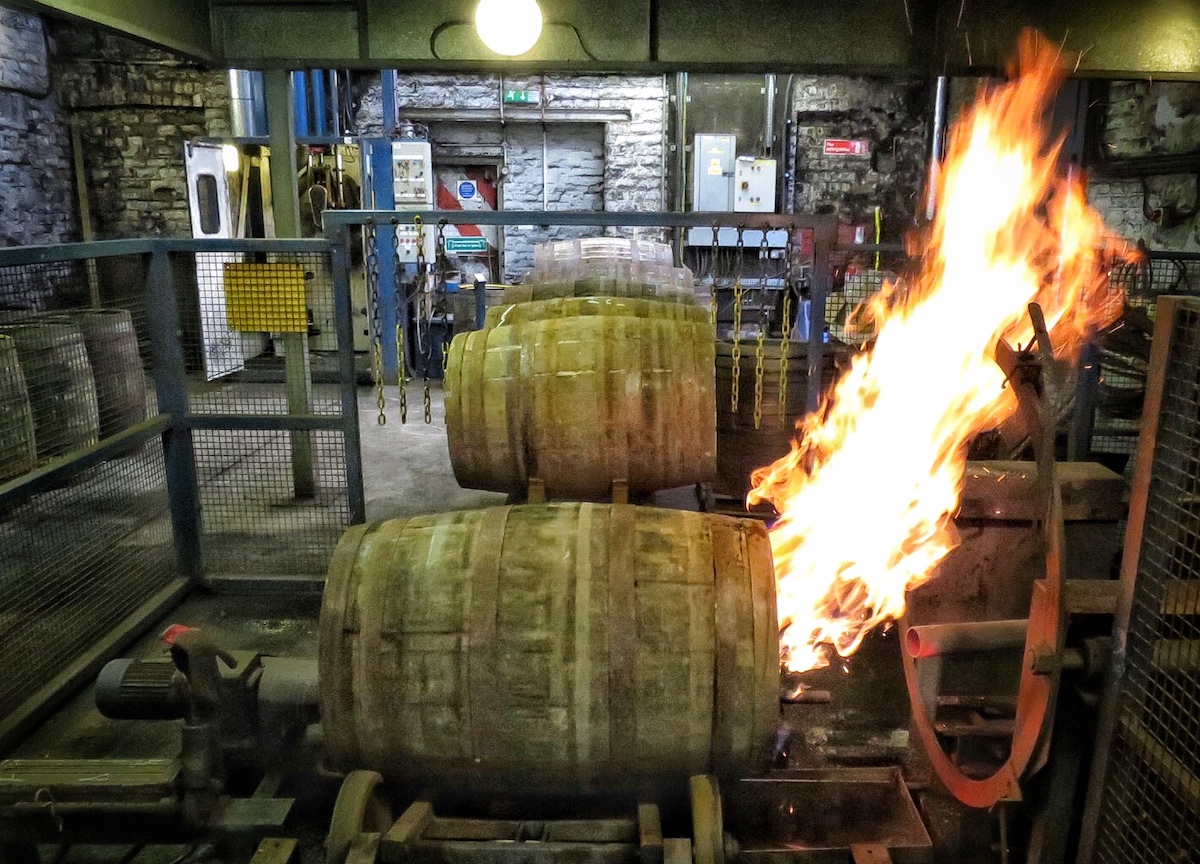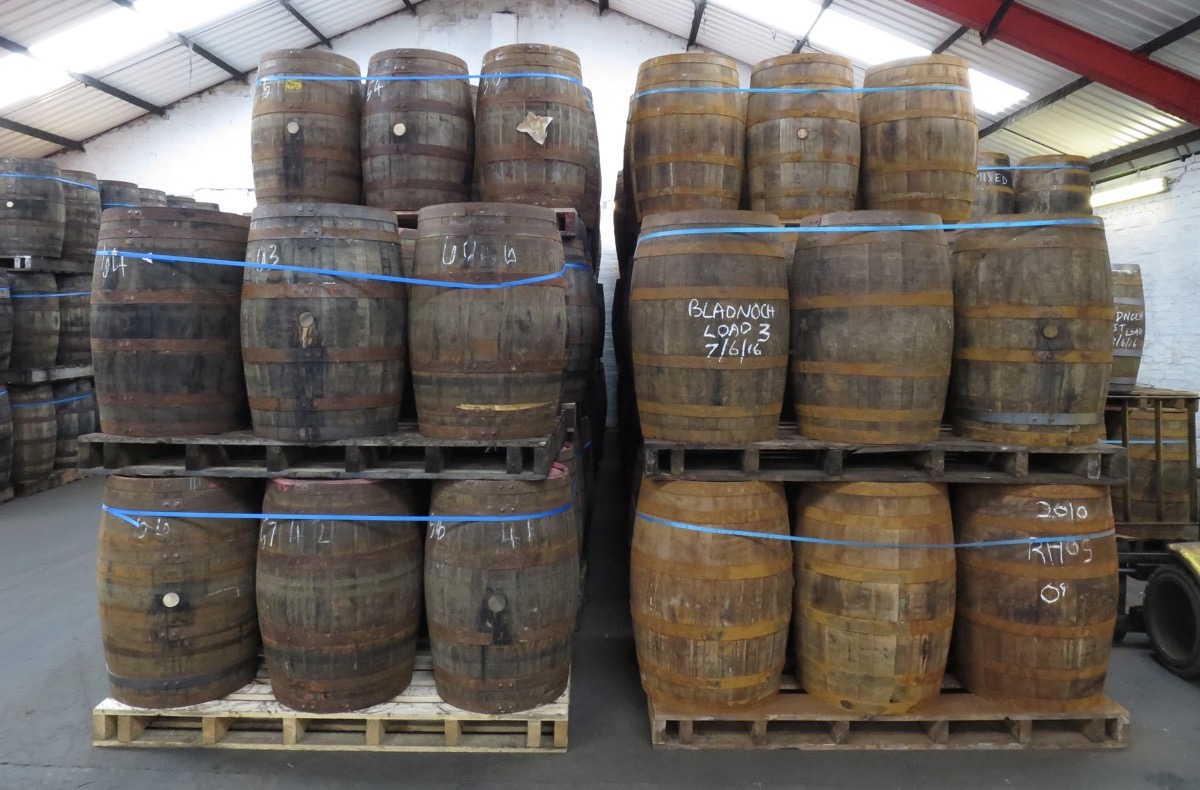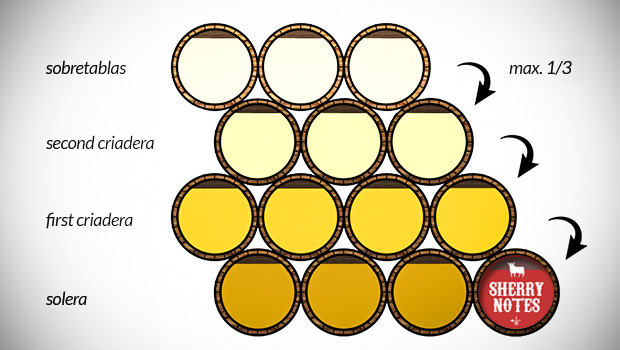There are lots of technical terms bandied around when talking about casks. This list will demystify some of them.
Alligator Char – a US term for the highest level of charring done to a cask. It’s also the most common level of char.
Amburana – a South American hardwood, occasionally used for maturing cachaça and very occasionally for maturing whiskey. It imparts a distinctive tonka-bean flavour, combining vanilla, coconut and cherries.
American Oak – an oak native to America, Most commonly used to mature American whiskey when new, but reused to age and rest many other spirits around the world. Also known as Quercus Alba.
American Standard Barrel – a 200 litre cask.
Angels’ Share – the spirit that evaporates from cask while it is maturing.
Barrel – strictly speaking, an abbreviation of American Standard Barrel, but often used (inaccurately) to refer to any type of cask.
Barrique – a cask used in wine and brandy production which is also used to mature whisky after the winemakers are done. Usually 225 litres, although there are also larger 300 litre casks used by Cognac makers.
Bilge – the bulging section around the waist of a cask.
Blood tub – a 30-50 litre cask
Bung – a piece of wood (or occasionally rubber) used to seal the hole in a cask
Bung cloth – a piece of hessian wrapped around a bung before it is inserted into the bung hole. It makes it easier to extract the bung and also helps keep the seal liquid tight
Bung extractor – a tool used to pull out bungs. It is screwed into the wood of the bung and then pulled to extract it.
Bung hole – the hole drilled out of the bilge or head to allow filling and emptying.
Bung stave – a stave with a bung hole drilled into it.
Butt – a 500 litre cask.

Casks being charred at Loch Lomond distillery
Char – the burnt top layer on the inside of many casks, which acts as a filter during maturation.
Chinkapin – a type of American white oak with scientific name Quercus Muehlenbergii. It is very rarely used in whiskey maturation.
Copper Dog – aka Dipping Dog or Whisky Thief. A thin tube of copped with one end sealed and a chain attached. It can be dipped into a cask to remove a small quantity of whisky and is then easily hideable for sneaking spirit out of a warehouse.
Croze – the groove on the inside of a cask at top and bottom that the head slots into.
Dechar/Rechar – a cask that has had the layer of char scrapped off before being recharred. This rejuvenates the cask, exposing new wood to the spirit that is filled into the cask.
Dunnage warehouse – a traditional warehouse where casks are stored on the sides, racked on top of each other.
European Oak – a term that encompasses a number of different oak species, but is generally used to refer to Quercus Robur. The flavour characteristics of casks made from European oak vary widely depending on the provenance of the wood.
First fill – a cask that has been used once before and has been refilled.
Head – the circular section at the top and bottom of a cask.
Hogshead – a 230-250 litre cask. Often made by adding extra staves to an American Standard Barrel.
Hoop – a band of metal that holds a cask together.
Limousin – an area of France around Limoges famous for its oak forests and the casks made from the trees. It is one of the primary areas that Cognac and Armagnac producers use as a source for their casks.
Mizunara – a species of oak that is found in Japan and north-eastern Asia. Also called Quercus Mongolica Crispula or Quercus Crispula. Not to be confused with the very similar Quercus Mongolica Mongolica – Mongolian oak – which is also being used to mature whisky.
Octave – a 50 litre cask

Palletised warehousing. The stacks often go much higher
Palletised warehouse – a warehouse where casks are stored on their ends, stacked on pallets which themselves are stacked on top of each other.
Paxarette – a concentrated wine used for flavouring and colouring. It was often used to season sherry casks, giving them a punchy of sherry flavour. However, the practise has been against Scotch whisky regulations since the late 1980s/early 1990s.
Pièce – a 205 litre cask most-often used in French wine-making.
Pipe – a cask used for maturing port. 350+ litres in size, and usually closer to 500 litres.
Quarter cask – a 125 litre cask, one quarter of a butt.
Quarter-sawn – a method of breaking down a log such a way that the grain is more vertical through the planks. It increases the strength of the planks and allows more grain contact when they are made into casks.
Quercus Alba – the scientific name of American white oak.
Quercus Mongolica – the scientific name for Mizunara.
Quercus Robur – the scientific name of the most common type European oak.
Racked warehouse – a warehouse with shelves for storing casks on their sides.
Reed – a piece of material (traditionally dried reeds) pressed between the head and the croze to make a cask water-tight at the ends.
Refill cask – a cask that has been used to store spirit at least twice: first as virgin oak, then as first-fill, before being filled again as a refill cask.
Rejuvenated cask – another term for dechar/rechar.
Seasoned cask – casks that have had another liquid stored in them specifically to infuse the wood with some of the characteristics of that liquid.
Seasoning – the process of drying a piece of wood to make it more suitable for use as in building a cask.
Shave/Toast/Rechar aka STR – a process similar to dechar/rechar where a cask has a small amount of wood removed from the inside of the cask to reveal more active wood, which is then toasted and recharred. A method pioneered by the late Dr Jim Swan

A solera. Image courtest of SherryNotes
Solera – in sherry, a system of continuous fractional blending where a notional row of casks is combined by occasionally drawing some sherry from the final cask, leaving the cask still with liquid in, and then refilling it from the previous cask in the row. That cask is refilled from the previous one and so on until the first in the row, which is refilled with new sherry. In whisky, it often refers to a single vat from which a whisky to be bottled is drawn, without emptying the vat, before being refilled with a new batch of the same whisky.
Stave – one of the pieces of wood that make up the sides of a cask.
Sulphur stick – a stick of sulphur burnt inside a cask to disinfect it before filling. No longer commonly used, but some older casks still have a sulphuric note from their earlier use. Much hated by whisky-writer Jim Murray.
Toast – the process of heating the staves of a cask, activating the flavour compounds within and helping them bend into the shape.
Tronçais – a large forest in the centre of France. Oak from the forest is used to make casks for Cognac and Armagnac producers.
Tun – a large vat used for marrying multiple casks.
Valinch – a long, tapered tube used for extracting whisky from a cask. The valinch is inserted through the bung hole and allowed to fill. The user then place their finger over the hole at the end, stopping air from getting into the tube, and the valinch is removed. As air can’t get in the end, the whiskey (mostly) stays in the tube, allowing it to be poured into a glass.
Virgin oak – oak that has not been exposed to a spirit before; a first-use cask.






 Enjoy responsibly
Enjoy responsibly
Comments
[…] For more cask info check out our Glossary of Terms. […]